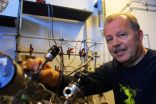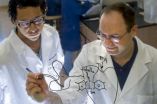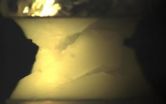(Press-News.org) While questions persist about the best ways to detect breast cancer early, a CT imaging system developed at the University of Rochester Medical Center and first unveiled five years ago is in a better position today to enter the fray -- at least in a supporting role to conventional mammography.
URMC radiologist Avice O'Connell, M.D., was invited to summarize the studies conducted thus far on the Cone Beam Computed Tomography (CBCT) scanner, at the Radiological Society of North America Annual Scientific Assembly in Chicago at 8:30 a.m. (EST) on Friday, December 3, 2010.
O'Connell is optimistic about the progress: The CBCT provides high-quality images and, importantly, is easier on women because it allows accurate breast scans without having to pull, flatten and compress the tissue.
In addition, preliminary research shows that breast coverage and radiation dose is comparable to mammography. Yet at this point researchers do not believe the CBCT is likely to replace mammography as a frontline screening tool. More studies are needed to verify its best usage in the clinic.
"The CBCT imaging system has some significant advantages over current imaging modalities however its greatest potential may be as an additional tool for diagnosing difficult cases. It could be extremely useful in locating tumors that are obscured by dense breast tissue, or distinguishing between benign and malignant lesions," said O'Connell, associate professor in Imaging Sciences and director of women's imaging for the Comprehensive Breast Care Center at the James P. Wilmot Cancer at URMC.
A team of URMC researchers introduced the CBCT system at the 2006 RSNA meeting. Dozens of women sought information about enrollment in clinical trials to test the new device, saying they were eager to participate in research that could lead to more comfortable, accurate, annual mammograms.
The CBCT scanner produces three-dimensional images while the breasts are in a more natural state. (Tomosynthesis is another new technology being developed for breast screening. It constructs a 3D picture of the breast using multiple x-rays, whereas the CBCT is an actual 3D image, O'Connell said.) The patient undergoing a CBCT scan lies on her stomach on a cushioned exam table – the design of which is still being improved – as one breast at a time is suspended through an opening in the table. The radiation source is positioned so that exposure to the chest or other areas of the torso can be avoided.
The scanner takes 300 high-resolution images while circling the breasts for about 10 seconds, emitting a radiation dose that's comparable to a diagnostic mammogram and within the limits set by the Food and Drug Administration. Radiologists will also be able to use the CBCT images and related software to perform biopsies directly on the table, O'Connell said.
Following is a summary of the data O'Connell will present at RSNA:
An initial trial of 23 women who were known to be cancer-free and to have had routine, normal, screening mammograms, also volunteered to undergo scans on the CBCT system. The study's only objectives were to evaluate image quality, coverage, and radiation dose. Some of the volunteers had dense breasts, which are more difficult to screen and often require a higher dose of radiation to obtain additional views if a problem is suspected. Dense breast tissue is fairly common: at least 25 percent of all women undergoing screening mammography, and particularly younger women and those who take hormone therapy, have dense tissue, which can greatly reduce the sensitivity of mammography.
Researchers found that the CBCT provided quality images of the entire breast, from the chest wall to the nipple, with a contrast resolution that was adequate to detect masses and calcifications 1 millimeter or larger. The study was published in August 2010 in the American Journal of Radiology.
A follow-up study of 42 women included volunteers who were known to have abnormal mammograms, and in need of a biopsy. Researchers compared the mammography images to those from the CBCT scanner. The CBCT detected all abnormalities and cancerous lesions, O'Connell said. Data from this study is being presented for the first time at RSNA 2010, and has not yet been published in a peer-reviewed journal.
O'Connell has begun a new clinical trial in collaboration with the University of Massachusetts. The objective is to compare CBCT and mammography images of 75 lesions and 75 calcifications to the pathology reports from the biopsies. This will allow researchers to further evaluate the accuracy of the scans.
Additional studies are planned to investigate the use of CBCT for those who cannot receive an MRI (a technology that uses magnets and radio waves to produce detailed images), for women with silicone breast implant ruptures, and to evaluate the response to breast cancer treatment in cases where the disease is more advanced at diagnosis.
"As our studies continue, we are very excited about the potential of this technology and look forward to exploring many uses for the CBCT scanner in the clinic," O'Connell added.
INFORMATION:
The University of Rochester holds several patents on the Cone Beam system, which was invented by Ruola Ning, Ph.D., professor of Radiology at URMC and founder of the Rochester, N.Y.-based imaging start-up company, Koning Corporation. (www.koningcorporation.com) The University licensed the technology to Koning Corporation to make, use and sell CBCT scanners.
END
When doctors want their patients asleep during surgery they gently turn the gas tap. But Anaesthetic gasses have a global warming potential as high as a refrigerant that is on its way to being banned in the EU. Yet there is no obligation to report anaesthetic gasses along with other greenhouse gasses such as CO2, refrigerants and laughing gas.
One kilo of anaesthetic gas affects the climate as much as 1620 kilos of CO2. That has been shown by a recent study carried out by chemists from University of Copenhagen and NASA in collaboration with anaesthesiologists from the ...
Tampa, FL (Dec. 3, 2010) -- Dynamic regulation of the chaperone protein Hsp27 was required to get rid of abnormally accumulating tau in the brains of mice genetically modified to develop the memory-choking tau tangles associated with Alzheimer's disease, a University of South Florida-led study found.
Researchers at the USF Health Byrd Alzheimer's Institute demonstrated that the effective switching of Hsp27 between its active and deactivated states was critical on two fronts -- to promote the recycling of the tau protein in healthy nerve cells and to clear abnormal tau ...
Could information technology and data mining techniques be used to improve the diagnosis and treatment of depression? That's the question scientists in Australia hope to have answered in a forthcoming issue of the International Journal of Functional Informatics and Personalised Medicine.
Maja Hadzic, Fedja Hadzic and Tharam Dillon of the Digital Ecosystems and Business Intelligence Institute, at Curtin University of Technology, in Perth, explain how depression is rapidly emerging as one of the major health problems now facing society. They add that the World Health Organization ...
YANG Nan, MAO ZongWan and SUN HongZhe et al., at the Department of Chemistry, University of Hong Kong and Sun Yat-sen University have characterized a series of bismuth citrate complexes by X-ray crystallography and modeled the structure of ranitidine bismuth citrate, a medicine used widely for the treatment of peptic ulcer and gastric reflux disease. The polymeric framework of bismuth citrate may serve as a "drug carrier" for delivery of other drugs in the human body. This significant contribution is reported in SCIENCE CHINA Chemistry 2010, 53(10).
Elements that possess ...
Scientists have discovered that the alteration of a single gene could cause some male embryos to develop as females.
The breakthrough will improve diagnosis and clinical management of patients with disorders of sex development (DSD). These conditions occur when the testis or ovary does not develop properly in the embryo, causing genital abnormalities in one in 4500 babies.
An international team including researchers from the Murdoch Childrens Research Institute and the University of Melbourne identified the gene alteration in a group of patients including two families ...
The Web surfing history saved in your Web browser can be accessed without your permission. JavaScript code deployed by real websites and online advertising providers use browser vulnerabilities to determine which sites you have and have not visited, according to new research from computer scientists at the University of California, San Diego.
The researchers documented JavaScript code secretly collecting browsing histories of Web users through "history sniffing" and sending that information across the network. While history sniffing and its potential implications for ...
Our research at the State Key Laboratory of Palaeobiology and Stratigraphy, Nanjing Institute of Geology and Palaeontology, has shown, based on a refined division and correlation of the graptolite-bearing strata in southern Jiangxi, China, that the Kwangsian Orogeny commenced in the early Katian Age of the Late Ordovician. Because of its significant research value, this study is published in Issue 11 of Science China Earth Sciences.
An angular unconformity separating the Lower-Middle Devonian and underlying strata is widespread in the Zhujiang region of South China, and ...
Mumbai, India – The International Rice Research Institute (IRRI) and the Asia Society launched a new food security report for Asia in Mumbai today, calling for increased investment in rice research.
The report, Never an empty bowl: sustaining food security in Asia, emphasizes the importance of rice as the primary staple food in Asia and a major source of income for Asian farmers. Existing global efforts to combat hunger and achieve food security are evaluated in the report, which also recommends more research on: climate change mitigation for farming, farming infrastructure, ...
VIDEO:
Hit it hard and it will fracture like a solid, but tilt it slowly and it will flow like a fluid. This is the intriguing property of a type of...
Click here for more information.
The new findings will be highly useful to the manufacturing industry because the processing and dispensing of everyday products like toothpaste, cosmetics, pharmaceuticals and foodstuffs depends on an understanding of the physical properties and behaviours of these fluids.
The research ...
Scientists studying a column of Antarctic ice spanning 650 years have found evidence for fluctuations in biomass burning--the consumption of wood, peat and other materials in wildfires, cooking fires and communal fires--in the Southern Hemisphere.
The record, focused primarily on carbon monoxide (CO), differs substantially from the record in the Northern Hemisphere, suggesting changes may be necessary for several leading climate models.
The research appears in Science on Dec. 2, 2010, in an early online release.
The scientists studied variations in stable (non-radioactive, ...




